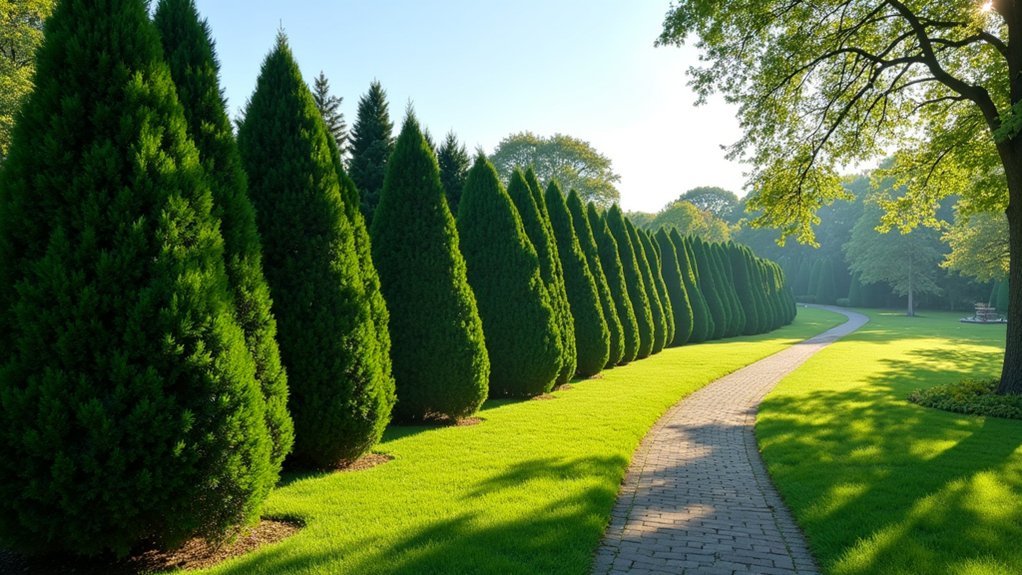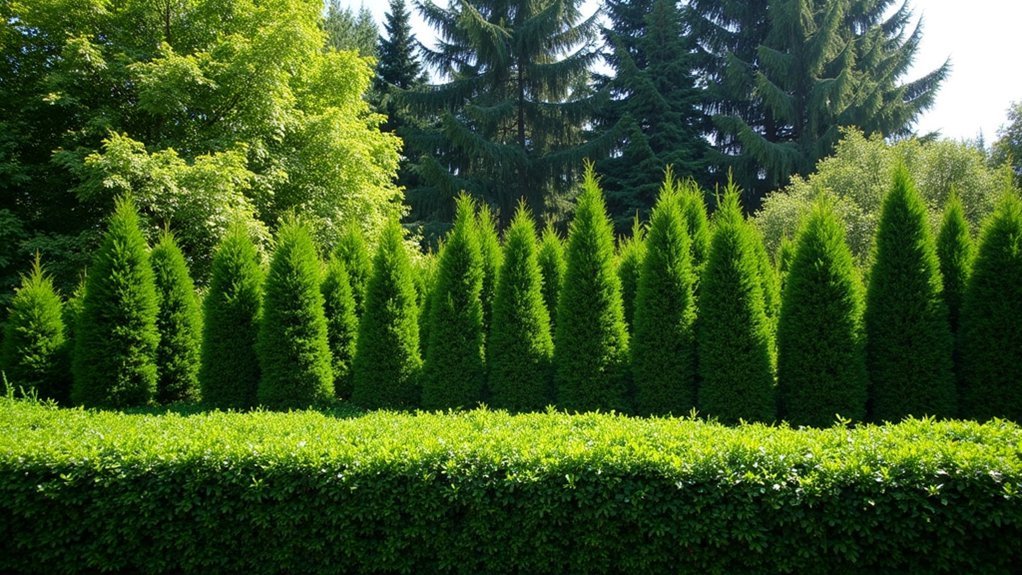For effective noise reduction, plant dense evergreens like Leyland Cypress or Thuja Green Giants 3-5 feet apart in staggered rows. Create barriers at least 25 feet thick using multiple species to absorb various sound frequencies. Position your bushes within 10 feet of noise sources and maintain a minimum 6-foot height. Prune during dormant seasons to promote thick growth while preserving outer shape. Implementing multi-layered strategies with tall, medium, and ground-cover plants offers the most thorough sound protection.
Dense Evergreen Varieties That Block Sound Effectively

When selecting plants for noise reduction, dense evergreen varieties stand out as the most effective natural sound barriers available to homeowners. Leyland Cypress and Thuja Green Giants top the list, reaching impressive heights of 50-60 feet with thick foliage that absorbs and deflects unwanted noise when planted in close formation.
Dense evergreens create nature’s soundproofing system, with Leyland Cypress and Thuja Green Giants serving as premier acoustic shields for the home landscape.
For smaller spaces, consider the Emerald Green arborvitae. Plant these just 3-4 feet apart to create an effective barrier with their soft, thick foliage.
The Carolina Sapphire Cypress offers another excellent option, combining dense, aromatic foliage with adaptability to various soil conditions.
When designing your sound barrier, remember that mixing different evergreen varieties enhances noise reduction by addressing multiple sound frequencies simultaneously, giving you a more thorough solution to neighborhood noise problems.
Optimal Planting Distances for Maximum Noise Reduction
Creating an effective sound barrier requires strategic spacing of your evergreen bushes, as proper planting distances directly impact noise reduction capabilities.
Position your evergreens 3 to 5 feet apart to form a dense barrier that effectively absorbs and deflects sound waves. For enhanced protection, implement staggered rows with 3 to 4 feet between plants in each row.
Your evergreen bushes should extend at least 25 feet deep using mixed species to reduce noise levels by up to 10 decibels.
Place your plantings within 5 to 10 feet of the noise source for immediate buffering effects. Maintain a minimum height of 6 to 8 feet to block line of sight to the source, further enhancing your sound barrier’s effectiveness.
Pruning Techniques to Enhance Sound-Dampening Properties

Proper pruning transforms ordinary evergreen bushes into exceptional sound barriers by encouraging denser foliage growth where sound waves can be trapped and diffused.
Time your pruning during the dormant season to minimize stress and maximize healthy growth for the following year.
When pruning your evergreen bushes, focus on removing dead or weak branches to create space for new growth, resulting in a thicker noise barrier.
Thin inner branches while maintaining the outer shape to improve air circulation and light penetration, which promotes dense foliage development.
For best results, maintain your evergreen bushes at a height and width that exceeds your noise source.
This strategic pruning approach guarantees your living sound barrier continuously improves its ability to absorb and deflect unwanted sound waves, creating a more peaceful environment around your property.
Multi-Layered Planting Strategies for Comprehensive Sound Barriers
Three distinct layers of evergreen plantings can transform a basic noise barrier into an acoustic fortress for your property. For maximum noise reduction, aim for a planting density of at least 25 feet thick with ground-to-canopy foliage, which can reduce noise by up to 10 decibels.
Create acoustic tranquility with strategic evergreen layers, reducing noise by up to 10 decibels when planted in 25-foot dense formations.
Implement these multi-layered planting strategies for ideal results:
- Position tall Cypress trees at the back to intercept and deflect initial sound waves.
- Plant mid-height evergreens like Nellie Stevens Holly in the middle to absorb different noise frequencies.
- Add low-growing ground cover plants at the front to muffle remaining sound and prevent erosion.
This staggered approach using both broadleaf and coniferous evergreens creates versatile sound barriers that address various noise frequencies while maintaining visual appeal.
Strategic Placement: Where to Position Bushes for Best Results

While most homeowners instinctively place evergreen bushes along property lines, strategic positioning is essential for maximizing their noise-reduction capabilities.
Plant your evergreen bushes as close as possible to the noise source rather than near your home for ideal noise-blocking. Create staggered rows to increase thickness, which helps deflect sound waves more effectively than single-row plantings.
Take advantage of your yard’s natural topography by positioning bushes on elevated areas, greatly enhancing their sound-dampening performance.
Consider layering different varieties of evergreens to address various noise frequencies. Always verify that the foliage extends to ground level—gaps underneath bushes allow sound to pass through unimpeded, compromising the entire barrier’s effectiveness.
This thorough approach transforms standard privacy plantings into efficient sound-reduction solutions.
Frequently Asked Questions
What Evergreen Hedges Are Best for Noise Reduction?
You’ll get the best noise reduction from arborvitae, holly, and cypress trees. Plant them in dense, staggered rows for maximum effectiveness. These evergreens provide year-round coverage with thick foliage that absorbs sound well.
What Shrubs Are Good for Noise Reduction?
For noise reduction, you’ll find hollies like Nellie Stevens, Blue Prince, and Castle Spire excellent choices. They’re dense evergreens that effectively absorb sound. Pairing them with azaleas and hydrangeas creates a mixed barrier that blocks various noise frequencies.
What Evergreen Trees Are Good for Noise Reduction?
For noise reduction, you’ll find Arborvitae (Thuja Green Giants), Leyland Cypress, Nellie Stevens Holly, Carolina Sapphire Cypress, and Italian Cypress highly effective. Their dense, year-round foliage absorbs sound while creating privacy in your landscape.
What Trees Are Best for Sound Absorption?
You’ll find Thuja Green Giants, Nellie Stevens holly, and Leyland Cypress are top performers for sound absorption. Italian Cypress works in narrower spaces, while mixed plantings of various evergreens provide the best overall noise reduction.
In Summary
You’ve now discovered how evergreen bushes can transform your noisy space into a peaceful sanctuary. By selecting dense varieties, spacing them correctly, maintaining proper pruning, creating multi-layered plantings, and positioning them strategically, you’ll maximize their sound-dampening effects. Remember, it’s not just about adding greenery—it’s about creating a thoughtful living barrier that’ll reduce noise while enhancing your landscape’s beauty and privacy.





Leave a Reply